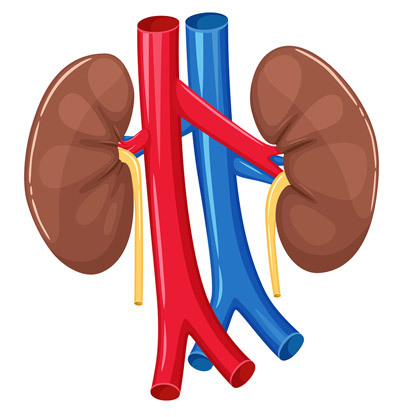HN4U Blog
Phosphorus and Your Kidneys
By Tammera J. Karr, PhD., BCHN ©2012
 I was asked to accompany a client to an appointment with their doctor to be a second set of ears and to help them remember more of the information and of course afterwards to talk about that information and share any insights.
I was asked to accompany a client to an appointment with their doctor to be a second set of ears and to help them remember more of the information and of course afterwards to talk about that information and share any insights.
What I learned about Kidney Disease on a Tuesday I was able to put to work on Friday and now am sharing it with you. Many individuals with chronic kidney disease are on restricted protein diets to reduce damage to the kidneys. It is my experience that there is important information not always being shared with these clients, that may be able to reverse or lessen the damage they are doing to the kidneys.
Phosphorus is an essential nutrient that helps form strong teeth and bones, metabolize fats and carbohydrates and create proteins within the body. This naturally-occurring element also assists the function of B vitamins, is important for the contraction of muscles, and the proper function of the kidneys, heart and nervous system. We obtain phosphorus through the food we eat, 800 to 1,000 milligrams (mg) of phosphorus a day is the limit for someone who has kidney disease. Most healthy adults may eat double this amount.
In a nutshell, a very small one at that, I learned the mineral phosphorus is hard on the kidneys and as the lab values for this mineral (part of a CBC panel) rise so does the potential for kidney damage. It is my understanding as a client enters stage three kidney diseases; doctors begin to check this mineral value more closely. But if we begin paying more attention to these numbers earlier and begin modifying the diet to limit phosphorus sooner, clients may be able to maintain kidney function. The number one cause of elevated phosphorus in the American diet is SODA POP in all forms containing phosphoric acid.
Food Additives & More: leavening agents such as baking powder contain huge amounts of phosphorus 38,890mg.
Apple cider-flavored drink, powder, low calorie, with vitamin C, Phosphorus: 2400mg
Coffee, brewed, espresso, restaurant-prepared, decaffeinated Phosphorus: 1400mg
Puddings, all flavors except chocolate, low calorie, Phosphorus: 1353mg
Gelatin desserts, dry mix, reduced calorie, with aspartame Phosphorus: 1306mg
Cheese, pasteurized process, cheddar or American, fat-free Phosphorus: 1265mg
Fruit-flavored drink, with aspartame Phosphorus: 1142mg
Foods, such as deli meats and colas, which have phosphates added in processing, are especially high in phosphorus. Phosphates are often used as a preservative or as an ingredient in processed foods. You must read food labels carefully and look for words that mean phosphorus; Phosphoric acid, Dicalcium phosphate, Monocalcium phosphate, Pyrophosphates, Hexametaphosphate, Polyphosphates, Sodium phosphate.
Any food that is not natural, that is processed will contain high levels of phosphorus.
SeaFood: Both fish and shellfish can provide a high amount of phosphorus in the diet. Saltwater fish, such as halibut, cod, tuna, whiting, sardines and salmon, provides around one third of the daily required intake of phosphorus for every 3 oz. of fish consumed according to the Linus Pauling Institute.
Meat & Dairy: Lean beef, turkey and chicken all have between 150 and 175 mg of phosphorus per 3 oz. serving. The University of Illinois indicates that some meat producers add brine to their meat products, which contains phosphorus in the form of alkaline phosphates. Cow’s milk, whether whole, reduced fat or nonfat, is also high in dietary phosphorus.
Nuts: Nuts contain high levels of phosphorus including almonds, cashews, walnuts, peanuts, and pistachios. Brazil nuts top the list, with just 10 average-sized nuts providing around one quarter of the daily requirement of the mineral. Other sources include lentils, beans and whole grain breads and cereals, although these plant-based sources are far less available than animal-derived food products. BUT if you are a vegetarian relying on nuts, lentils and beans for protein and you are at risk of kidney disease you may want to have your eGFR, creatine and phosphorus levels checked.
They Mayo Clinic and DaVita have a list of food options that are lower in phosphorus – like many medical sites there is some throwing out of the baby with the bath water… The higher nutrient content of real foods such as whole grains in my mind outweighs the lower level of phosphorus; because many individuals with kidney disease struggle with type 2 diabetes the benefits of healthy food choices for their blood sugars will increase fiber and reduce weight, better than focusing on white bread having less phosphorus than whole grain.
It is also important for those with potential kidney disease to be watchful of high levels of potassium; foods like peanut butter are high in sugar, potassium and phosphorus making it more than just double jeopardy for your kidney health.
Take Back Control of Your Health with information.
Interested in learning more?
Check Out Our Online Course
Let’s Begin the Journey of a Lifetime!


